
|
|
|
June 1998
A multi-way trade involving two museums, a public transit agency,
and a car builder transpired during the winter and spring of 1998, in which
The Branford Electric
Railway Assoc. (BERA) received a functional DifCo crane
and in exchange the Baltimore Streetcar Museum finally got
Baltimore crane 3715.
Those who have been around the Shore Line Trolley Museum for a few years
know W-3,
our 1929-built Differential Steel Co. all-electric trolley crane,
which came to us from Montreal Tramways in 1963. They know that
W-3 is used all year round, for anything from picking up ties to
towing cars. Those who have been around quite a bit longer
will remember the days when Branford did not have a crane, and all
these tasks which we now take for granted had to be done by grunt,
sweat and elbow grease. They remember that September day in 1956 when crane
car #3715 arrived from Baltimore. Suddenly, new barns started going
up, rails and ties were changed out, new line poles were set!
3715 was made by the Industrial Brownhoist company in 1913,
and was owned by United Railways and Electric, later known as
Baltimore Transit. This type of trolley crane, known simply as
a "Brownhoist", is essentially a trolley flat car with a mechanical
crane mounted on one end of the deck. As built, 4 Westinghouse 101
motors propelled the car itself, with a 5th motor inside the tub of the crane.
Through a complicated system of clutches, gears, pedals and levers,
this single motor powers all 3 crane functions: swing, elevation
and hook.
The Brownhoist crane was by far the most popular crane among trolley
companies. In the mid-1920s, a
competitor crane emerged with a greatly advanced design. Made by
the Differential Steel Co., later known as "DifCo", this was
an all-electric crane. Individual electric motors, each with
a drum-type rheostatic controller, power the 4 crane functions:
Swing (the boom and tub can rotate 360 °), elevation
(the boom can be raised or lowered 30 ° above or below
horizontal), hook up/down, and travel, a helpful feature which
allows the position of the hook to be traveled along the length
of the boom. All of these operations can be underway at the same
time, although safe operating practice dictates limiting the number
of operations to less than or equal to the number of appendages
one has free to operate the handles.
|
All in all, the Differential crane was vastly superior to the Brownhoist.
However, trolley times were tough, and only a dozen or so Differential
cranes were
ever built. One never left the carbuilder. In 1926, Differential built,
under factory
order number 649, a crane which they used as a "demonstrator", in other
words, a showroom model. This crane was also used as a utility
vehicle, hauling short trains of freight cars between the Differential
plant and their freight siding, and to hoist materials.
Several years later, in 1929, a single Diffy crane shipped to Montreal
Tramways, W-3, which BERA acquired in June of 1963. Its
versatility and ease of use quickly made it the crane of choice,
relegating 3715 to backup duty. The occasional heavy job made it
clear though that two cranes were better than one. Alas, 3715
over time wore out and broke down. The last major blow was a gear
failure which made the swing function inoperative. With considerable
time and money needed to restore the crane, it sat unused, and
in recent years its deck obeyed the law of diminishing flat surfaces
as various heavy metal objects were stored on it.
The
Baltimore Streetcar Museum (BSM) has
a collections policy that is clear and concise: Baltimore, Baltimore
and only Baltimore, so it is only natural that they sought 3715.
The Baltimore system is wide gauge, very wide, 5' 4 1/2 " in fact.
When 3715 came to Branford, the Baltimore-gauge Brill 27G2 trucks
were taken off and replaced with a set of Wason arch-bar trucks
which came from a scrapped ConnCo work motor. The 4 WH101 motors
that came with 3715 were removed from the trucks and stacked neatly
in Barn 1.
BSM had inquired after 3715 several times, but BERA did not
want to part with it and be left with only a single crane. BSM
did get part of 3715 though, when 3715's
original trucks, sans motors, went down to BSM for a restoration
of a different car. And there things sat for many years.
The impetus for this large trade was a single Westinghouse 306CV
motor. BSM was in need of just one of these for a restoration project.
A BERA member became aware of the existence of one
in the possession of the San Francisco Municipal Railway.
During a phone call to BSM, the issue of 3715 was discussed.
Meanwhile, back in Findlay Ohio, the game was afoot. The DifCo
demonstrator, about which several museums including Branford had
inquired over the years, had become available. The crane had been
in active service until 3 or 4 years ago, when DifCo purchased a
small diesel switcher to replace it. The crane lost its indoor
storage spot. Last year, DifCo, which had remained a family
business, was bought out by Trinity Corporation, and the new
management wanted "that junk out of there". Here was an
opportunity to turn a unique deal!
When the steel dust finally settled, the scorecard read as follows:
BSM purchased the DifCo crane on BERA's behalf and sent it to us.
BERA sent 3715 to Baltimore, minus trucks (BSM had
no interest in those "narrow gauge" trucks). BERA traded a pair
of WH514 motors and one G.E. CP27 compressor to San
Francisco Municipal Railway, in exchange for one WH306CV motor, which
BERA sent to BSM, and a pair of WH510 motors (spares for Toronto Peter
Witt #2898). BSM in turn sent BERA a pair of PC5 switch groups,
one WH307 motor (spare for N.J. Public Service #2431), and a CP127
compressor (a higher-capacity version of the CP27, good for Philly
Master Unit #84). Speaking of Philadelphia, their broad gauge of
5' 2 1/4" is close enough to Baltimore's 5' 4 1/2 " to be rather
useful to BSM. BERA sent 6 Philly wheel/axle sets as well as a
Philly sweeper truck (minus motors) to BSM, in exchange for 4 standard-gauge,
streetcar-profile wheel/axle sets (3 of which have WH305 motors
still attached) which, in fact, came from DifCo. Got that?
All this was, in accordance with Board policy,
"at no cost to BERA". Per the bylaws, Director, Sustaining and
Supporting members had been notified by mail of the special meeting,
held on February 14th 1998, to consider the de-accession of 3715.
Several members attended the meeting and expressed favorable
opinions concerning the trade. The board then voted unanimously
to de-accession the car and trade it to BSM.
BERA wanted to give BSM a complete car, as they intend to do a
thorough restoration of it. About a month was spent
locating parts that had been separated from the car, including
a VanDorn-style radial coupler, a controller and brake valve
from the #2 end, the four original WH101 motors, and
miscellaneous small parts. 3715 had also become a storage flat
and its deck needed to be cleared for action. BERA members brought
W-3 up next to it and transfered four traction motors, two switch
groups, an R-17 motor-generator set, W-3's boom extender and
various other "light" (under 1 ton) parts to W-3. 3715's deck
got a good broom job and was clean probably for the first time
since it was acquired. Ongoing efforts over the past few years to
containerize our spare parts inventory meant that these items had
a safe, dry place to reside.
On April 1,1998, two trucks arrived in front of Sprague. One contained
the body of the new crane, the other its trucks and some spare
parts which Trinity-DifCo threw in. The next day, yet another crane
arrived on the property, this time a big construction crane.
It made short work of setting the two trucks down on the track
in front of Sprague, then lifting the crane body off the trailer,
allowing the trailer to be pulled away, and setting the crane down
on its trucks. W-3 then came up to Sprague and towed its cousin
into the carshop.
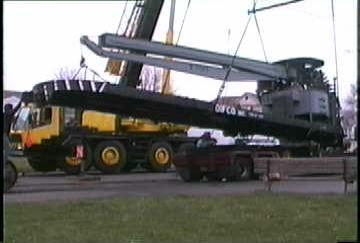 |
| The DifCo crane is hoisted off the flatbed truck |
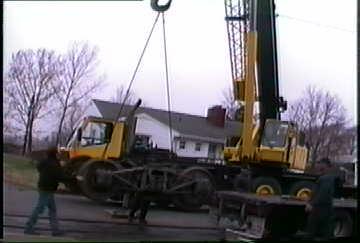 |
| The trucks for the DifCo crane are unloaded from the second flatbed |
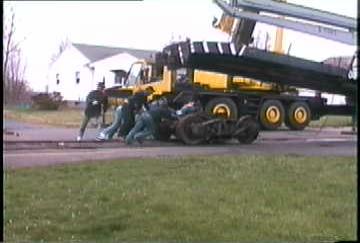 |
| Volunteers line up the DifCo crane's trucks under its bolsters |
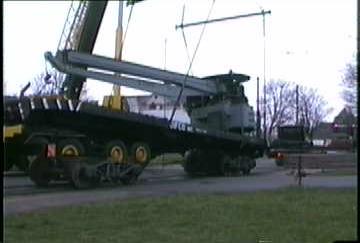 |
| The DifCo crane is lowered onto its trucks |
Moments later, car 3715 completed its last trip down Branford rails
with representatives of BSM at the handles.
Some adventurous souls crawled beneath
and carefully disconnected the brake rigging and motor leads. Then the
big crane hoisted 3715 off its trucks. The trucks were rolled out
from under the car and the trailer backed
in beneath it. 3715 was set down and W-3 towed the trucks back
to the yard for storage.
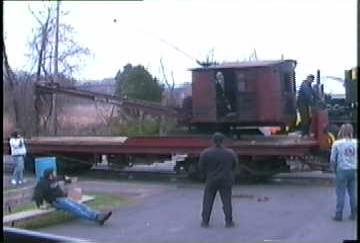 |
| Baltimore crane #3715 takes its final trip on Branford rails |
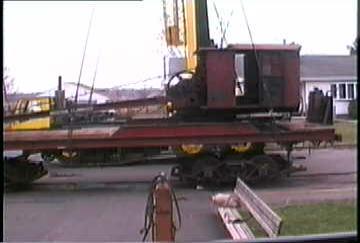 |
| 3715 is lifted off its trucks |
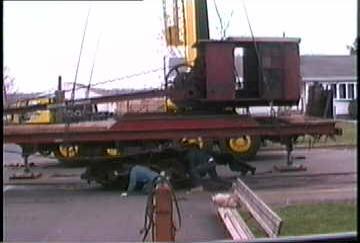 |
| 3715's trucks are pushed out from under it |
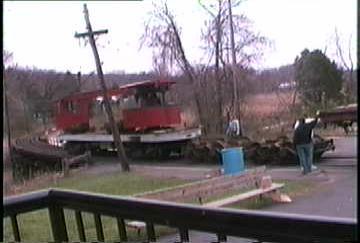 |
| The otherDifCo crane, Montreal Tramways W3, hauls off 3715's trucks |
3715 made the trip down to Baltimore where, we have learned, it
has had much care lavished upon it. One BSM member has been
saving a special grease gun all these years, waiting to welcome
the crane back home.
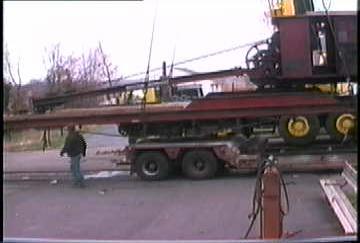 |
| 3715 is lowered onto the flatbed and taken down to Baltimore |
Meanwhile, back in our shop, the gang has been working on the new car.
This might very well be the first time that a railway museum has taken
delivery of a car straight from the car builder (if anyone knows otherwise,
please write). With the crane we also received boxes
of paperwork, including complete drawings for the car, and shop records
which shed some valuable light on the car's history.
By far, the biggest debate to date has been what to call the new crane.
The leading candidate is "649", the factory order number under which
the crane was constructed. The next raging debate will be over paint,
as at least 3 different paint schemes have been found under the
current battleship grey.
Stay tuned....this story will continue next month.









